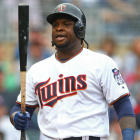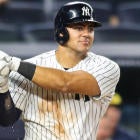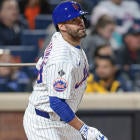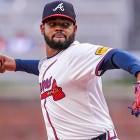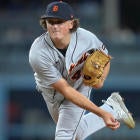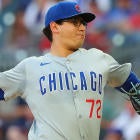Welcome to our 2019 Player Profiles series. We are going through the top-300 in Heath Cummings and Scott White's consensus rankings to give you the case for and the case against drafting each player. By the time you're done, you'll know everything you need to know for drafting in 2019.
Player Rankings: 1-10 | 11-20 | 21-30 | 31-40 | 41-50 | 51-60 | 61-70 | 71-80 | 81-90 | 91-100 | 101-110 | 111-120 | 121-130 | 131-140 | 141-150 | 151-160 | 161-170 | 171-180 | 181-190 | 191-200 | 201-210 | 211-220 | 221-230 | 231-240 | 241-250 | 251-260 | 261-270 | 271-280 | 281-290 | 291-300
191. Alex Wood, SP, Reds
The case for: Neither the Dodgers nor the Braves before them seemed to have a great appreciation for what Alex Wood has to offer, shuffling him between the starting rotation and bullpen whenever it suited them. The Reds, though, won't have that luxury, having acquired him with the intention of making him a rotation staple. His ground-ball tendencies should play well at Great American Ball Park, and his steady-if-unspectacular ERA, WHIP and strikeout rate will play better over 180 innings than 150.
The case against: "Unspectacular" is a fitting description for a pitcher who projects for a mid-threes ERA with less than a strikeout per inning, and if Wood's ground-ball tendencies aren't enough to keep the ball in the yard at a much smaller venue, things could get ugly fast. From that perspective, the upside may not be worth the downside.
192. Archie Bradley, RP, Diamondbacks
The case for: He might be the Diamondbacks closer. Manager Torey Lovullo said in December that he's leaning toward using Archie Bradley in the role, and it could work out just fine. He was one of the top relievers in baseball two years ago, compiling a 1.73 ERA, 1.04 WHIP and 9.7 strikeouts per nine innings, which made him the favorite for the closer role entering last year as well.
The case against: He might not be the Diamondbacks closer. Since Lovullo's comments, the team has signed Greg Holland, who has a long and mostly successful career as a closer and seemed to recapture his form with the Nationals last September. Bradley wasn't as effective in 2017 as 2018, but the stuff and SIERA were similar. Considering his so-so strikeout rate, though, last year may have been less the aberration.
193. Tyler Glasnow, SP/RP, Rays
The case for: Once regarded as one of the top pitching prospects in baseball, Tyler Glasnow showed his clearest signs of a breakthrough after coming over to the Rays in the Chris Archer deal last July. He upped his strike percentage to 63.4 and lowered his walk rate to 3.1 per nine innings, both of which would be by far his career bests if applied over a full season. And seeing as his 10.3 K/9 during that stretch would have placed him in the top 12 among qualified pitchers, the upside is palpable.
The case against: Throwing more strikes seemed to lead to bunches more home runs, giving Glasnow about the same ERA as a starter for the Rays that he had as a reliever with the Pirates -- and with a much worse FIP. His heavy reliance on a curveball should keep help keep the ball in the park over the long haul, but what if it doesn't? Or what if he slips into old habits? The chances still seem higher of things going wrong than right.
194. Corey Knebel, RP, Brewers
The case for: Corey Knebel looked like he was on the verge of joining the closing elite in 2017, putting together a 1.78 ERA, 1.16 WHIP and 14.9 strikeouts per nine innings. His 126 strikeouts actually tied Craig Kimbrel for tops among all full-time relievers. A hamstring injury cost him the first month last year and seemed to throw him off his game, but he finished with 16 scoreless appearances in September, striking out 33 while allowing just three walks and five hits.
The case against: As incredible as his finish was, Knebel needed a stint in the minors to get right, and it's never comforting when a pitcher in a high-leverage role can lose it so completely. Plus, we don't know exactly what his role is. Jeremy Jeffress was the one picking up saves down the stretch last year and had dominant numbers himself, and Josh Hader will always be a factor when the matchups are right. The Brewers may have the truest of closing committees in 2019.
195. Mike Zunino, C, Rays
The case for: There's power here. Mike Zunino is one of just three catchers coming off back-to-back 20-homer seasons, the others being Yasmani Grandal and Salvador Perez. And if you go by ISO, his .258 mark two years ago was better than what even Gary Sanchez delivered with his 33 homers that year. At a position so short bats, being good at just one thing can make someone an impact player.
The case against: Zunino really is just good at the one thing, and with strikeout rates that might lead the league if he had the at-bats to qualify, his downside is apparent. His .251 batting average in 2017 was mostly a result of good fortune, as his .201 mark last year showed. So while his power at least makes him a viable option, it comes at great expense, enough to render him practically unusable in points leagues.
196. Eduardo Rodriguez, SP, Red Sox
The case for: Eduardo Rodriguez's fastball-changeup combo has been pretty good at piling up strikeouts over the past couple years, his rate of 10.1 K/9 last year ranking among some of the game's elites. He's not exactly a liability in ERA and WHIP (though not a standout either), and the Red Sox offense gives him a reasonable chance at a healthy win total.
The case against: Of course "healthy" win totals are all the more attainable for pitchers who are, you know, healthy, which Rodriguez rarely is. He had surgery to correct a recurring knee issue last offseason but still missed a month and a half of 2018 with a sprained ankle and wound up finishing up in the bullpen. For all his strikeout ability, he's fairly hittable because he lacks a quality breaking ball and, thus, has only middling upside.
197. Miguel Sano, 3B, Twins
The case for: There was a time not too long ago when Miguel Sano looked like he'd go the Aaron Judge route, combining big fly-ball tendencies with some seriously hard contact for enough power to overcome what would normally be a debilitating strikeout rate. For now at least, he's projected to be a regular part of the Twins lineup.
The case against: "For now at least." Between poor conditioning, subpar defense, questionable off-the-field behavior and a mountain of health concerns, Sano has given the Twins ample reason to turn the page on him, and that's before factoring in that his excessive strikeout rate yielded a .199 batting average last year. He may still have a monster season in him, but you have to bet against one at this point.
198. Ryan Braun, OF, Brewers
The case for: You know the name Ryan Braun, right? Won an MVP once. Also got suspended for PEDs once, but it was only a big deal because he was so good. Well, he has fallen on hard times lately, his home run production and batting average both sagging over the past couple years, and in retrospect, it's amazing he used to hit for as much power as he did with such a low fly-ball rate. He has made efforts to elevate the ball more this offseason, working with a private hitting coach to reconfigure his swing.
The case against: At 35, he's unlikely to reverse the trend of sitting every fifth day or so to manage his health, so even if his new swing does make him a productive bat again, there are limits to his upside. It's probably safe to pass him over in three-outfielder leagues.
199. Jeremy Jeffress, RP, Brewers
The case for: Already one of the league's best at generating ground balls, Jeremy Jeffress figured out how to miss bats last year, and the result was some truly dominant relief work, his 1.29 ERA ranking second among relievers with at least 50 innings. It was enough to move him into the closer conversation, and in fact, he was the Brewers' top choice for saves in September of last year.
The case against: Corey Knebel looked like the game's best up-and-coming closer in 2017, and after struggling to find his form for much of 2018, a brief stint in the minors last August led to him returning with some jaw-dropping numbers in September. It's hard to imagine he won't factor into the ninth inning at all, and of course, lefty Josh Hader will remain in the mix as well. Barring an injury, Jeffress' best chance for saves might be as part of a ninth-inning committee.
200. Harrison Bader, OF, Cardinals
The case for: Harrison Bader's defense has him positioned to be the Cardinals' everyday center fielder next year, and his bat is interesting enough to earn him admirers in Fantasy, his high line-drive rate somewhat validating his .358 BABIP. His home run and steal totals would seem to suggest there's 20-20 potential as well.
The case against: Even with a high BABIP, Bader hit only .264 because he struck out so much -- more than a player with his modest power has any right to, frankly. Practically speaking, he projects for more like Kevin Kiermaier numbers, which mixed-league owners won't find terribly exciting. And with the Cardinals trying to find at-bats for Jose Martinez, Dexter Fowler and Tyler O'Neill, the pressure's on him to perform right away.
Player Rankings: 1-10 | 11-20 | 21-30 | 31-40 | 41-50 | 51-60 | 61-70 | 71-80 | 81-90 | 91-100 | 101-110 | 111-120 | 121-130 | 131-140 | 141-150 | 151-160 | 161-170 | 171-180 | 181-190 | 191-200 | 201-210 | 211-220 | 221-230 | 231-240 | 241-250 | 251-260 | 261-270 | 271-280 | 281-290 | 291-300













